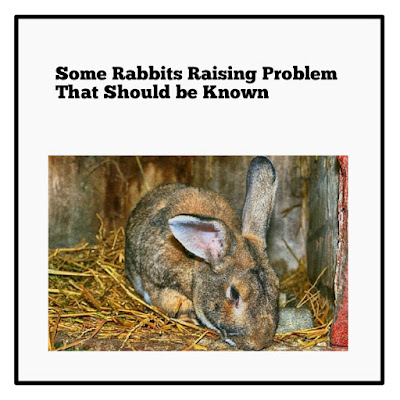Rabbits are monogastric or non ruminants animal with just one or simple stomach.They are medium sized hopping animal mamamals with long legsomg ears, and short tail. Rabbit meat are reared for their meat. Rabbits is regarded as white meat.
Terms used for Rabbits
Buck - This is an adult male rabbit.
Doe - This is an adult female rabbit.
Kitten/Warren - This is a young or baby rabbit.
Hutch - This is the house where rabbit lives.
Pelt - This is the skin of rabbit.
Litter - These are all the young one that are produced at a time sometimes by one Doe(adult female rabbit).
Kidding - This is referred as the act of giving birth in rabbit.
Sucking- Feeding of young ones on the Doe breast milk.
Dam - the mother of a set of young rabbit.
Sire - the father of a set of young rabbits.
Characteristics of Rabbits.
1. They are small medium sized body animals.
2. Rabbits are easy to house.
3. Rabbits are very Prolific as they can produce many litters.
4. Rabbits have a short gestation period of 30 to 31 days.
5. They grow fast and reach the size and weight of maturity within 5-6 months.
6. Rabbits are susceptible to stress.
7. They can resistant diseases.
8. Cattles have the weaning period of six to eight weeks.
9. The meat of rabbit is very delicious and nutritious.
10. Rabbits are fur- covered skin.
11. They don't stress and easy to rear.
Breeds of Rabbits
Common breeds of Rabbits includes:
1. California white
2. Flemish giant
3. California Red
4. New Zealand white
5. Champagne d'Argent
6. The crosses
7. New Zealand Red
8. Lop
9. Chinchilla
10. Blue Beveren
Characteristics of Some Rabbit Breeds
1. The Chinchilla : This is grey bodied animal and it usually weight up to 5kg at maturity size.It is one of the best fur or pelt producer and a good meat producer
2. The New Zealand White : This is the most popular for meat production.It is a fur breed and can attain 4.5kg at maturity in eights months.It is very good as it convert feed to meat in a short time.It is very fast maturing breed of rabbit.
3. Angora : This breed need a very good attention and a lot of care. This rabbit is reared for it's wool .It's most common colour is white.It has wool on its ears and feet.
4. The Giant Flemish : This is the largest of all the rabbits breeds.This breeds can weigh over 5kg in its maturity age.This breed is dark steel grey in colour and has a very hard skin.It is a very great meat producers.
5. California White : It is a light breed and it's adult weigh 3.5kg to 4.5kg. It is characterised by black markings on the ear, feet,tail, nose. It has a high growth rate with good meat.
6. The New Zealand Red - This breed is bright red in colour and weigh over 3kg .It has rapid growth and good food conversion to milk.
Importance of Rabbits
1. Meat : This meat of rabbit is white, fine, grained, tender and nutritious.The meat of rabbit is among the most nutritious meat, even, more nutritious than poultry chicken.
2. Rabbits Skin or Pelt - The skin on rabbit can be used for making jacket, carpet, rugs, mats and other decorative households or ornamentals.
3. Manure : Rabbit manure is high in nitrogen and phosphorus which can therefore be used for improving the fertility of the soil.
4. For research purposes: National Veterinary Research Institute keep rabbits for research and findings.
Problems Militating Against the Production of Rabbits.
The major problem includes:
1. Unpredictable breeding behavior of rabbits
2. Inadequate supply of concentrate feeds due to high cost of getting it.
3. Inadequate sanitations and proper sanitation programs.
4. Incidence of respiratory problems liks snuffles and pneumonia.
5. Insufficient capital to embark on large production.
6. It is labour intensive.
Housing of Rabbits.
1. Rabbits are kept in hutches.
2. Wooden or metal hutches with wire netting are used the most.
3. The male rabbit are kept from the female within the rabbitery.
4. The hutches are arranged in single, double and triple tiers.
5. The floor of the rabbitery should be concrete for easy cleaning.
6. The roof of hutches should be made of corrugated iron sheets or asbestos sheets.
Feeding of Rabbits
1. Rabbits have one stomach and they are herbivorous as they only feed on plants.
2. Rabbis are given pellets to enhance their growth.
3. Water should be supplied to rabbits a the time.
4. The protein for the adult should be 12-15% while that of pregnant and nursing be 16 - 20%
5. The pellets can be supplemented with aspilia africana, sweet potatoes, Amarantus, water leafs, centrosema spp, Emilia spp, tridax spp.
Hygiene / Health of Rabbits
Common hygiene should be adopted in rabbitery which includes:
1. Clean the floor of rabbitery daily.
2. Isolate sick animals from others and treat them.
3. Remove cob-webs from rabbitery regularly
4. Disinfect the rabbitery at regular intervals to keep them away from diseases ann germ s.
5. Don't keep weeds around rabbitery.
6. Deworm rabbits regularly.
7. Remove and bury dead animals.
8. Clean the food and water troughs to prevent them from contamination.
Diseases of Rabbits
The common disease of rabbits include:
1. Coccidiosis
2. Ringworm
3. Mixomytosis
4. Sore Hock
5. Enteritis
6. Helminthiasis
7. Bloat
8. Mastitis (nipples inflammation)
9. Pneumonia
1. Coccidiosis : This is caused by protozon.The symptoms of course coccidiosis in rabbits includes: passing of soft feaces which may have blood stain, loss of appetite,loss of weight, death of rabbit in severe cases.
Control measure include: raising of rabbits in cages made of wire, treatment of affected rabbit by a doctor.
2 Enteritis: This is caused by protozoa feed changes, stress or poisoning. The symptoms include: high temperature , diarrhoea, loss of appetite, watery feaces which is unusual.
Control measure include: Make sure you adopt good feeding regime, maintain good sanitations for rabbits, avoid the lumping together of young ones from different Doe.
4. Bloat: This is caused by the feeding disorder ( this is when animals eat too much green feed too fast). The symptoms include: respiratory difficulty, distended stomach
Control measures include: feeding rabbit with balanced diet , do not let the rabbits to get too hungry before feeding them.
5. Ringworm: This diseases is caused by fungus. The symptoms include: loss of hair on the affected skin and circumscribed lesion on skin.
Control measures include: isolate affected rabbits and use fungicide to cure lession.
6. Mixomitosis : This is caused by virus.The symptoms include high fever, runny nose, untriftiness.
Control measures include : isolation of the affected ones, treat rabbit with antibiotics to reduce cross infection.
7. Helminthiasis : This diseases is caused by worms.The symptoms include poor growth, diarrhoea, constipation.
Control measures include: Deworming regularly and practising good sanitation.







0 Comments